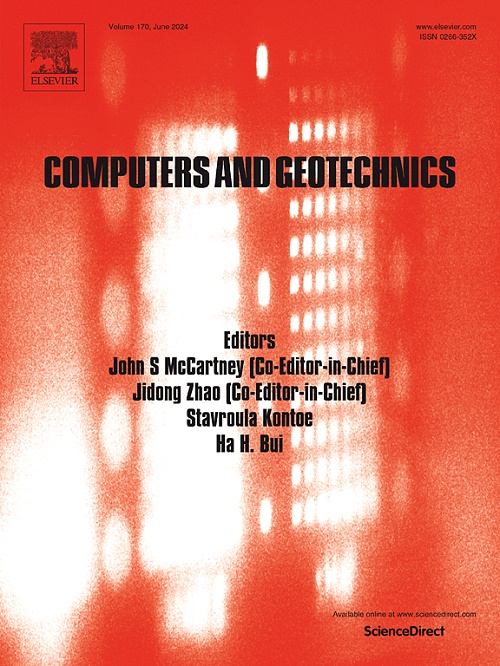Modelling the crystalline swelling process of montmorillonite incorporating boundary effects
IF 5.3
1区 工程技术
Q1 COMPUTER SCIENCE, INTERDISCIPLINARY APPLICATIONS
引用次数: 0
Abstract
Crystalline swelling behavior of montmorillonite (Mt) profoundly impacts the phenomenological properties of expansive clays. Accurately modeling the evolution of basal spacing is essential for assessing the performance of expansive clay materials in geotechnical applications, particularly in high-level radioactive waste (HLRW) repositories. This study aims to address the primary limitation of existing crystalline swelling models, which fail to account for boundary effects dependent on clay structure. A mass transfer boundary is integrated into the Laird model, and its validity is substantiated through basal spacing measurements of tactoids and bentonites. The mass transfer boundary is described using the soil water retention curve (SWRC) for bound water. Furthermore, net hydration energies are determined using an empirical function, eliminating the need for experimental calibration of effective diabattivity. The modified model is validated against experimental data for three common bentonites: GMZ, MX-80, and Kunipia. It demonstrates enhanced predictive accuracy compared to the previous model and effectively captures the continuous swelling process. Additionally, this approach provides a numerical tool for calculating the evolution of potential energy and dielectric constant within interlayer spaces.
结合边界效应的蒙脱土晶体膨胀过程模拟
蒙脱土的结晶膨胀行为深刻影响膨胀粘土的现象学性质。准确模拟基底间距的演变对于评估岩土工程应用中膨胀粘土材料的性能至关重要,特别是在高放射性废物(HLRW)储存库中。本研究旨在解决现有晶体膨胀模型的主要局限性,即未能考虑依赖于粘土结构的边界效应。将传质边界整合到Laird模型中,并通过土突和膨润土的基间距测量证实了其有效性。用束缚水的土壤保水曲线(SWRC)来描述传质边界。此外,使用经验函数确定净水化能,从而消除了对有效失热率的实验校准的需要。对GMZ、MX-80和Kunipia三种膨润土进行了实验验证。与之前的模型相比,该模型的预测精度得到了提高,并有效地捕获了连续的膨胀过程。此外,该方法还为计算层间空间内势能和介电常数的演变提供了数值工具。
本文章由计算机程序翻译,如有差异,请以英文原文为准。
求助全文
约1分钟内获得全文
求助全文
来源期刊

Computers and Geotechnics
地学-地球科学综合
CiteScore
9.10
自引率
15.10%
发文量
438
审稿时长
45 days
期刊介绍:
The use of computers is firmly established in geotechnical engineering and continues to grow rapidly in both engineering practice and academe. The development of advanced numerical techniques and constitutive modeling, in conjunction with rapid developments in computer hardware, enables problems to be tackled that were unthinkable even a few years ago. Computers and Geotechnics provides an up-to-date reference for engineers and researchers engaged in computer aided analysis and research in geotechnical engineering. The journal is intended for an expeditious dissemination of advanced computer applications across a broad range of geotechnical topics. Contributions on advances in numerical algorithms, computer implementation of new constitutive models and probabilistic methods are especially encouraged.
 求助内容:
求助内容: 应助结果提醒方式:
应助结果提醒方式:


